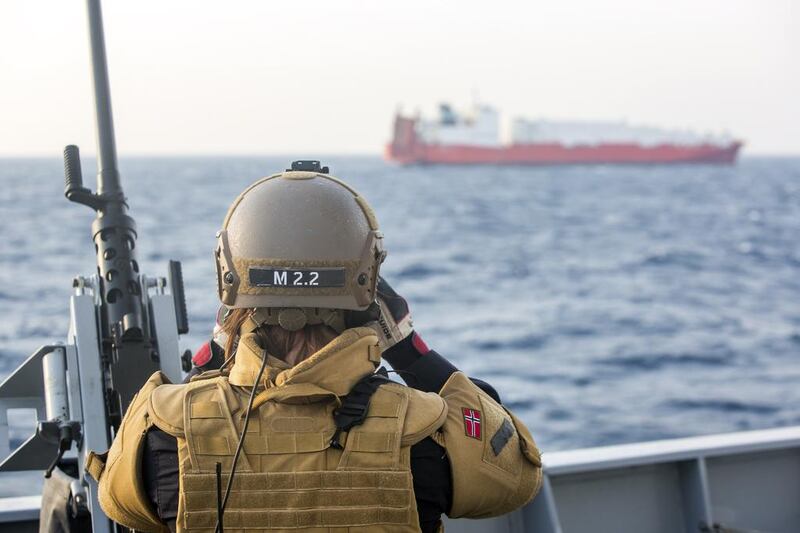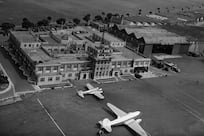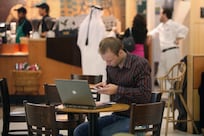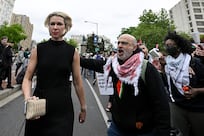BEIRUT AND AMMAN // International military commanders based in Jordan were on the brink of ordering air strikes against a “strategic weapons” store in southern Syria, according to accounts of a dramatic incident last week.
With rebels closing in on the fortified bunker at the Tal Al Jabiyeh military complex in south-western Deraa, military and intelligence officers from the US, Europe and Arab states who staff a clandestine operations room in Amman, scrambled to make sure the weapons inside did not fall into the hands of Al Qaeda-affiliated rebels.
The precise nature of the munitions in the facility remains unclear, with officials in the Military Operations Command (MOC) in Jordan, said to have consistently referred to them as “strategic weapons”.
A defector previously based on the compound informed officials that a high security bunker on Tal Al Jabiyeh contained the nerve gas sarin.
Syria has one of the world's largest chemical weapons programmes and nerve agents have already been used in the three year civil war, with hundreds of civilians killed in a complex attack on rebel-held suburbs of Damascus last summer.
While a UN investigation strongly indicated regime forces were responsible for that attack, the prospect of those weapons falling into the hands of Islamists militants has been a persistent worry for the international community, as the Syrian state crumbles.
In a tense four-hour period on Tuesday night last week, rebels involved in the assault – including Jabhat Al Nusra – were warned by officials in the command centre that Israeli jets were on standby to bomb a bunker on which they were advancing, less than 8km from the border with Israel.
Accounts of the event were given by three different sources, familiar with the situation around Tal Al Jabiyeh and with the workings of the international command centre.
Jordan denies the existence of the international operations command centre, which monitors the Syria conflict and oversees the distribution of weapons and funding to allied rebel units fighting against forces loyal to Mr Al Assad.
None of the Western or Arab states that have intelligence and military staff working at the MOC has publicly acknowledged it, but the centre’s existence has become an open secret.
The night of Tuesday, February 25, appears to have been one of the command centre’s most fraught periods, as a sense of panic set in at the prospect of an Al Qaeda faction getting its hands on the weapons stockpile.
The command centre has not intervened in this way when other regime storage facilities in Deraa province have been overrun, and has been content to let the rebels share out any weapons they capture.
This time, however, as fighting around the Tal Al Jabiyeh facility raged and the prospect of it falling into rebel hands came closer to reality, the command centre bluntly demanded guarantees from rebel forces that they hand over to it any weapons stored in a white, reinforced concrete bunker with thick metal, electrically operated shutters blocking its east facing entrance.
Rebels were told if they failed to give that guarantee, an Israeli airstrike would immediately be called in on the area to destroy the entire compound and everything in it.
This ultimatum was passed on, through an intermediary, to Jabhat Al Nusra’s emir in Deraa province. The Nusra leader agreed to leave weapons in the bunker alone, as did all of the other rebel units in the area.
In the early hours on Wednesday, February 26, four hours after the first call, rebels were contacted again by the Amman command centre and told to expect an “international operation” directed at the weapons bunker.
With the rebels pushing to take control of the Tal Al Jabiyeh, the operations room immediately halted all weapons supplies to the assaulting forces, apparently in a successful effort to delay their advance on the bunker.
Without supplies, the rebels were forced to consolidate their positions around the base and not seek to break in.
Over the following 48 hours, regime units were reinforced, shoring up their defences and, by Saturday, they had pushed back against the rebels.
The immediate crisis involving a rebel-take over of the base was averted as the assault ground to a halt.
Details each of the three sources gave of the account accurately matched, and included information they asked not to be made public which strongly supported their accounts. The sources also asked that their identities not be revealed.
The situation at Tal Al Jabiyeh remains fragile with the complex still surrounded by an alliance of at least nine rebel units, including Al Nusra, the Al Qaeda affiliate in Syria, and Ahrar Al Sham, part of the Islamic Front. Others are more closely aligned to the operations room, and have received training from US military forces in Jordan.
Notions the Tal Al Jabiyeh facility contained more than run-of-the-mill weapons were underscored on Monday, when leading local figures from besieged opposition areas, including Nawa, met the regime’s governor of Deraa province, Mohammad Khaled Al Hanous to ask that food supplies to be allowed in.
Accounts of that meeting have Mr Al Hanous saying that, if opposition forces came close to taking Tal Al Jabiyeh, regime units would obliterate Nawa, a town once home to 95,000 people — now down to about 30,000 and currently ringed by government troops.
“Tal Al Jabiyeh is a red line, the Americans, Israelis and Arabs will never get it, if you try, Nawa will be wiped out,” Mr Al Hanous was described as saying by a resident of Deraa province.
Last Tuesday’s sudden flurry of activity suggested the sensitive nature of the weapons facility had caught the command centre by surprise.
Rebels it supports routinely give advance knowledge of their operational plans, and request weapons to carry out attacks.
The assault on Tal Al Jabiyeh had begun on Monday, not with the aim of taking the weapons bunker, but, rather, to strike regime units that have carried out damaging attacks against rebels.
Since last Tuesday’s events, the operations centre had held emergency meetings on the situation in Tal Al Jabiyeh, according to one of the sources.
Weapons supplies have still not resumed to rebel units in the area, which suggests the opposition’s international backers do not want the attack on Tal Al Jabiyeh to proceed.
Under a UN-brokered deal to decommission its chemical weapons programme, Syria has submitted a declaration to the OPCW in which it is supposed to have detailed all associated facilities, although Western diplomats have cautioned it may have sought to hide supplies.
The contents of that declaration have not been made public.
Attempts to contact the OPCW about the Tal Al Jabiyeh complex were unsuccessful.
Rebels said the base contained an off-limits warehouse, with an unusually high level of security, even compared to ballistic missiles bases elsewhere in the country.
“It was a very high security bunker, no one was allowed near it, not even senior officers it had a tighter security system than other military facilities,” said a rebel officer who had been on the base before the Syrian uprising began in nearby Deraa in March 2011.
“We don’t know what’s in there but it seems to be something important, a strategic weapon of some kind, perhaps missiles, perhaps chemicals or biological agents,” he said.
Rebels in southern Syria backed by the operations room, launched a new offensive last month, intended to put more pressure on Mr Al Assad to negotiate, following failed peace talks in Geneva.
psands@thenational.ae





